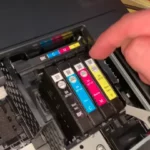Summary
The primary causes behind the STOP 0x00000004 are generally hardware failures and malfunction of device drivers.
The INVALID_DATA_ACCESS_TRAP error can occur on any of the Windows NT based operating systems, such as Windows NT, Windows 10, Windows 8, and so forth.

It has a variety of minor causes, including the likes of mismanaged registries, corrupted uninstallations, etc.
In hindsight, any blue screen of death with a stop code appears when the computer is trying to prevent fatal data loss as it fails to function normally due to backend reasons.
Reasons Behind the Error
There are a plethora of reasons for this error, while the main culprit is often found to be either hardware failure or an issue with a device’s driver.
The hardware failure of any component can send the computer into iffy. The components may start malfunctioning or stop working altogether-essential components such as hard disk, RAM, motherboard, graphics card, or the processor.
- Corruption in CMOS can also cause this error. CMOS in BIOS can be corrupted due to the malfunctioning of drivers, power fluctuations, etc.
- Malfunctioning of drivers of the newly installed devices.
- Logical errors in the hard disk partitions
- Corruption, error in memory.
Solution #1 Analyze recent changes | System Restore
Have you made a recent change or addition of a new computer component? Or, installed new software, drivers on the computer.
If anything mentioned above, then it may be the right time to roll back those changes to the less turbulent times.
Observe and analyze if things were functioning normally before the changes.
You can always create a restore point in time when your computer is at peak performance with stability.
- Search for “create a restore point” in the Start Menu search bar.
- Select a drive under the Protection Settings in the System Protection tab.
- Click on Configure and then tick the option that says “Turn On System Protection”
- After that, go to the Disk Space section and allot the size for making a system image. Set it to 10% of the total capacity as a thumb rule.

The next time you can revert to old changes and avoid getting the blue screen of deaths. This applies to software issues only.
Note: This method works for software on computer issues only. Hardware related triggers may still cause BSODs. By the way, you can try Wondershare Recoverit to recover lost data after system restore.
Solution #2 Update Device Drivers
Outdated, corrupted, or incompatible drivers can wreak havoc on a computer at any point in time.
It becomes increasingly important when new devices, components have been installed on the computer.
The device may require an exclusive set of drivers to run/perform on an optimal basis.
You have two ways to update drivers.
- Manually load drivers from the DVD, which is generally provided with the devices. Or, go to the site of the device manufacturer and download it from there.
- Use the Device Manager to automatically download and install drivers by searching for them online.

Solution #3 Check Disk for Errors
Hard disk partitions often get corrupted due to logical errors as well as physical errors. You can use the most potent tool shipped with Windows to fix disk errors.
While there are many third-party applications in the market for the exact purpose, the CHKDSK tool by Microsoft does a stellar job in doing a considerable amount of damage control.
CHKDSK, as we know, is a command-line based tool that helps the users keep the integrity intact of their storage volumes.
- Open an elevated command prompt with administrator rights.
Press Ctrl+ Shift+ENTER while selecting the command prompt to open it with administrator rights.
- Type the following commands and press ENTER.
| chkdsk c: /f /c |

The process will take some time to complete, so do not close the command prompt or stop the process before it gets completed.
The letter C denotes the drive letter in which the Windows is installed. You can change it according to your driver letter pattern.
Additionally, you can also run the scan for all the drives to ensure that all the drives are error-free.
Note – System partitions on the NTFS file system are locked in. It will prompt for scanning on the next restart. Type Y and press ENTER to schedule a scan.
Solution #4 Reset the BIOS
Hardware compatibility issues can arise as a result of altered BIOS settings by different drivers.
You can clear the CMOS, which will reset the BIOS settings to its default state. There are various ways to do it, but we list 2 of the easiest ways to do it.
Method A
1] As the computer’s power button lights up, immediately press the BIOS key to enter the BIOS dashboard.
The shortcut key is general F1, F2, F10, or F12. On older machines, it is generally ESC key, combinations such as Ctrl+Alt+ESC or Ctrl+Alt+Delete.
Search for your motherboard or laptop model, as it may vary.
2] After you have entered BIOS, search for the reset to the default option, which is generally found in the EXIT tab of the BIOS.
Modern BIOS user-interfaces have shortcut keys for all essential functions.

Depending on the BIOS security setup, it will ask for the password to confirm the reset action.
3] After confirming for the reset, the computer will restart, and BIOS shall reset to its factory default.
Method B
The second method is more mechanical and requires you to open the CPU cabinet or laptop’s back panel.

You will find a spherical battery, the size of a penny or a quarter installed in a motherboard socket.
Remove the battery for a few seconds and put it back. It will reset the BIOS to its default state, similar to what we did in Method A.
Note: You can also clean the socket with a dry cloth if you like.
Besides, you can also learn more methods to fix the common BSOD error here.
Conclusion
Touching the BIOS settings is a risky business that should be done with utmost caution and a backup plan.
Always keep the drivers up to date and install software(s) from verified publishers whenever possible. It will help in keeping the blue screen of deaths at bay.
You might like.
- Fix Msvcp100.dll Missing.
- “BOOTMGR Is Missing” – How to Fix?
- Fix System Service Exception Windows 10 Error.
Join 25,000+ smart readers—don’t miss out!








